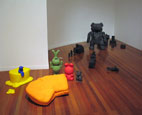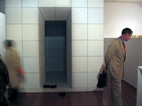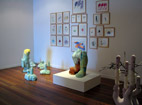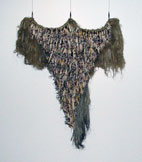


Stop the Ceramics Bus - I want to get on that Vehicle of Culture!
Zen Parry
[Editor's Note: This is the third of a series of letters from artist Zen Parry describing her experience of the 2005 Third World Ceramic Biennale in the Republic of South Korea.]
Hello Forrest,
The Symposium has opened, with a panel tasked to address a specific issue each day. The panel was composed of: Kwan-ho Woo (Korea), Simon Groom (UK), Michio Sugiyama (Japan), Chan-dong Kim (Korea), Judith Schwartz (USA), Moyra Elliot (New Zealand), Gabi Dewald (Germany), Kazuo Yamawaki (Japan), Paul Smith (USA), Edmund De Waal (UK), Koos de Jong (The Netherlands), Robert Harrison (USA), and Ole Lislerud (Norway).
The first session was all about "Reframing Ceramics"—with an opening address by a rather provocative gentleman, Simon Groom, who is head of Exhibitions and Displays at the Tate, Liverpool. He curated a show entitled "A Secret History of Clay, from Gaugan to Gormley," and, given the comments, it is still raising hackles! What ever he did to 'reframe ceramics' drew a lot of comments, both during the session, and in the bar afterwards!
Following Groom was a series of artist presentations that varied from the sublime to the indulgent. Piet Stockmans (Belgium) relied on music and imagery, culminating with a series of nude forms taken from young nubile women—go figure—or get over it! Thankfully, Richard Slee (UK) didn't pull any punches and stayed true to form with his searing honesty and below average presentation skills. Tony Marsh (USA) tied his artistic themes and phases together with eloquence, while Liu Jianhua (China) convinced me (and quite a few others in the audience) that he really doesn't like women—as evidenced in his installation in the Trans-Ceramic Art exhibitions.
Day two promised another menu for the audience to select from. "Global Support and Inter-exchanges of Ceramic Art" proved to be a rather dull topic, until Gabi Dewald (Editor-in-Chief of Keramik Magazine, and Chairman of ICMEA, the International Ceramic Magazines Editors Association) took the platform. Not that Gabi is controversial, rather when she spoke, we all listened and enjoyed her perspective. Given that her magazine competitor was also attending the conference, it was good to hear Gabi's point of view and her frankness as she discussed the issues that need to be managed to make a ceramics magazine successful and respected.
Robert Harrison gave a rousing slide show on the Archie Bray organization—I think we all wanted to apply as soon as the projector was turned off! Paul Smith shared his perspective on museums and ceramics and their various relationships based on 45+ years in the design and craft fields, culminating as Director Emeritus of the American Craft Museum. Sook-Kyung Lee moderated the panel.
In between presentations, I dashed about the Icheon complex, checking out the exhibitions, or grabbing some of the amazing fast food or trying to see "just one more thing..." I felt like a kid in a play park—it was a lot of fun. I earned my most frequent visitor miles at the Trans-Ceramic Art exhibition.
There were some familiar names to be seen, and a list of participants that were completely unknown. Kudos to the curator of this exhibition, Jaeyoung Kang, who no doubt traveled high and low locating these stunning works.
Top of the list in my mind, a fellow Australian and a good friend, was the work of Michael Doolan—his signature figures. Another stunning work was a scene from the Last Supper or The DaVinci Code by Marek Cecula from Poland. Christina Doll had her ceramic house shipped from Germany; she and her assistant Axel, spent the better part of a week reassembling it, tile by tile. Stepping inside, one found video images from childhood.
Elsa Sahal's work always drew a crowd - of both artists and audience. Kristen Morgin presented one of her amazing cars constructed of raw clay—I visited Scripps College (California) before flying to Korea and had seen her work, along with that of Tony Marsh and Yuh Sun-Koo. Yuh's work was shipped from that show to Icheon, and in a bigger setting, didn�t seem as monumental, until one stood next to it.
Another riveting installation was by a young Danish sculptor, Claus Domine Hansen (www.domine.dk) who had cast fragments of contemporary life, such as a credit card, which then became a disturbing fossil when inserted into jars of liquid. It immediately evoked images of objects in jars filled with formaldehyde, lined up in a scientists� lab.
The incorporation of technology was a theme throughout the works. I'm sorry I don't remember the names of the artists, but I have included two images—the green image shows ceramic forms on the floor and this projected image over it. The audience stood and watched for long periods of time. Another image I sent you is a bit deceptive. In a hidden corridor, there were 5 large bowls (4+ feet in diameter), lit from above and filled with water. This created lighted, round discs in the darkened space. It was difficult to find orientation in this setting, until a random drop of water fell and broke the surface of the water. Very Zen!!
Overall, this inclusion of technology seemed to invigorate ceramics and bring new perspectives to the material and the manner in which it is being worked. As an artist who predominantly works with clay, as opposed to a clay artist, I have had quite a few dark days—my stack of rejection letters could become a college course! Seeing my own work in the greater context was like getting a good shock to the heart. I was so pleased to see the work of others, reminding me constantly of the value of working hard and attending such events.
The last day was all about the "New Horizon of Ceramic Art." Ole Lislerud presented his public art commissions for architecture and Judith Schwartz talked of money, politics, globalization and the role of institutions in 21st century ceramics. Both lectures were worth the battle against fatigue. The event wrapped up at a stunning riverside home, studio and gallery of Korean artist Kyoung-Hwan Won, complete with a scripted sunset, great ambience, and above all, a chance to talk with the participants on a personal level. It seemed a fitting conclusion to an intense 10 days.
As I bundled myself back onto the bus to return to the hotel, the events started to seep into my weary bones. This experience defies a decent explanation through words. The sheer scale of the exhibitions and geographic richness of this area of Korea are destined for success. This event is billed as the largest ceramic event in the world, and I don't doubt it. The Biennale carries the largest cash prize of any competition in ceramics—$65,000 big ones, no strings attached. What remains to be seen is how other organizations will respond to this event and compete to exhibit the best that artists can offer.
What I have described to you Forrest, is barely one third of what was taking place. I haven't even mentioned the other symposium taking place, or the events being held in parallel in each of the cities of Gwangju and Yeoju. It will all require a return visit in 2007!
Ciao,
Zen
Links
Zen Parry
http://www.ovoo.com
The World Ceramic Biennale
http://www.wocef.com
http://www.worldceramic.or.kr









